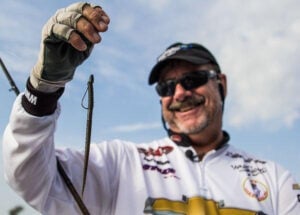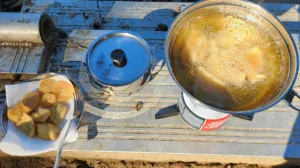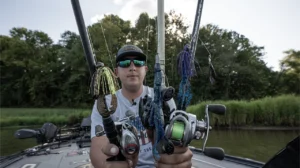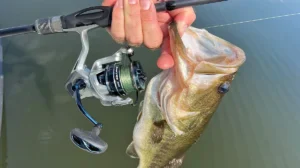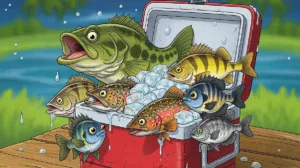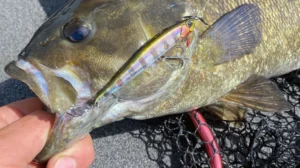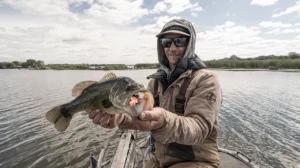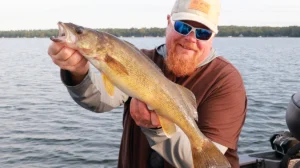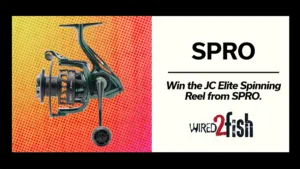FLW Tour pro Larry Nixon is a big believer in fishing backwater areas for bass. Throughout his illustrious career, he’s caught hundreds of giant bass in hard-to-reach, shallow sloughs when other many competitors fell short. If there’s anyone whose brain you’d need to pick in regards to dissecting these backwater areas, he’s the man to talk to.
Fall just so happens to be an excellent time to target your local backwaters. As the water temperatures drop into the low 70 to high 60-degree range, bass gorge themselves on the abundant shad in preparation for the upcoming winter months.
According to “The General”, there are 6 important factors you need to know in order to catch more big bass out of backwater areas.
- The age of bass matters
- Learn what separates good areas from great areas
- Focus on edges
- It won’t always be a slugfest
- Process of elimination is key
- Simple presentations that will fool these finicky bass
1. Big bass are like retirees
If you can fish a nearby main river area and catch 50 bass each day, committing to shallow backwaters can be tough for many anglers. Rest assured, however, that big bass frequent these areas. In many situations, they actually live there throughout the entire year. A simple hypothetical question can help put things into perspective.
When you retire, would you rather live in a crowded, crime-laden city or would you rather live in a quiet suburban house which requires very little maintenance?
Most people would choose the latter option, and bass are the exact same way. Nixon believes old bass are, indeed, lazy bass.
“An old, fat bass doesn’t want to deal with current and a bunch of smaller bass trying to steal their food,” Nixon said. “They know that, in order to survive, they have to stay in the backwaters where they’re less exposed to the elements. They can hang out in the shade, eat big bream and not have to fool with fighting strong river current.”
2. Essential things to look for in shallow backwaters
Most backwaters have no shortage of stumps, laydowns or standing timber, so don’t get too carried away when you find a flooded forest when beginning your search. There are 3 very important factors that backwater areas must have in order to host a quality concentration of big bass.
- Vegetation—”If you have vegetation, such as hydrilla or milfoil, that produces oxygen in the water, you’ll have baitfish that will stay there almost year-round,” Nixon said. “When there’s baitfish in an area, resident big bass will stay there as well. It’s a simple, but foolproof formula.”
- Current—”If bass are going to hang out in a backwater all year long, there has to be some type of current,” Nixon said. “It may only happen twice a day when someone goes through a lock, but it needs to be somewhat consistent. Wind helps, but it won’t hold those fish in an area all year because it’s not consistent enough to maintain high oxygen levels or keep the water clarity suitable.”
- Depth changes—”A significant depth change can be almost nothing—sometimes just one foot in a backwater,” Nixon said. “Even if it’s a silted-in, nasty bottom, it’s still a depression and that’s what really matters to bass. These very small depth changes are travel routes for both bass and shad because they will always take the path of least resistance.”
3. Backwater bass love edges
‘Edge’ is one of Nixon’s most sought-after characteristics when fishing backwaters. By his definition, an edge is anywhere there is a change in cover or bottom composition. Sometimes it’s as subtle as a row of 6-inch diameter pine stumps transitioning into a row of larger hardwood stumps. Backwater bass will take anything they can get.
“Bass are total edge lovers, just like deer,” Nixon said. “Whether it’s a creek channel or a simple grass line edge, it’s all the same thing to them. If you can learn to look for edges, you can catch more backwater bass.”
There are 2 key questions that Nixon asks himself when he notices an edge in shallow sloughs.
- Where does this edge go?—”I have to be able to drain the backwater and read submerged cover to the best of my ability,” Nixon said. “You need to take clues from the visible edges you see, such as a stump row, and find out where they lead. A lot of the best cover won’t be visible, so this is important.”
- How far does it extend?—“It’s important to know how far an edge extends from the last point you can visibly see,” Nixon said. “If I quit fishing a stump row because I can’t see the stumps anymore, I’m putting myself at a major disadvantage. Often times you can find edges that extend into small ditches, and these are the types of areas that hold giant bass.”
4. Find that special 1 percent
There will always be resident backwater fish that are uncatchable. Without consistent current flow, they will suspend on any cover they can find and become totally inactive.
“When resident fish suspend, you’re not going to catch them unless you drop a bait right on their nose,” Nixon said. “The odds of doing that are awful, so it’s important to find the 1 percent of a given backwater in which the bass are active. There is a lot of dead water to cover before you find the special spot.”
If you start getting bites in a specific area, don’t just shrug it off. The bass bit for a reason, and most backwaters are very spot-specific. Just because you caught a bass off certain type of stump doesn’t mean you can duplicate it elsewhere. Nixon stresses the importance of slowing down and saturating productive areas.
5. Eliminate dead water
“It’s important to go through a process of elimination every single day,” Nixon said. “I spent over 18 hours this year on the Red River just eliminating dead water. It’s always hard work catching backwater bass.”
It’s not a particularly sexy technique, but Nixon simply ‘goes fishing’ when dissecting backwater areas. As he makes specific flips and pitches to cover, he keeps a close eye on his electronics. Finding key depth changes is often what leads him to tournament victories.
“If you make notes, or waypoints, of everywhere you catch a bass, you’ll be able to paint a picture pretty quickly,” Nixon said. “You’ve got to keep your eyes glued to your graph because you might find a small side-ditch that intersects with a primary ditch to create a point. Before you know it, you’ve ‘accidentally’ found an area that gets hit by current, holds baitfish and plays host to really big bass.”
His method is fairly simple. If there is vegetation in the area, he starts by targeting it before moving on to secondary cover such as wood or pad stems. In areas void of vegetation, he targets wood cover adjacent to break lines.
“You’ve got to fish the tar out of everything you see,” Nixon said. “Like I said, backwaters are extremely spot-specific, so you have to eliminate every piece of cover individually.”
6. Nixon’s backwater confidence baits
It’s not necessary to have a pile of 30 rods on your front deck with fishing shallow backwaters. Nixon has narrowed down his tackle selection to these 4 tried-and-true techniques:
- Big squarebill crankbait—”If the water is relatively warm, I love a big crankbait with a wide wobble that I can bang into wood,” Nixon said. “The Bagley’s Diving Killer Bee 1 and Diving Killer Bee 2 crankbaits are absolutely perfect for this. They cover the 0 to 5-foot depth range and never get hung up. They’re very buoyant, so I don’t have to constantly get my lure unhung. They’re extremely hard to find. I actually have a secret stockpile of them because I love ’em so much.”
- Heavy spinnerbait—”If the water has a little color to it, you can’t beat a 3/4-ounce spinnerbait with a big No. 6 blade on the back,” Nixon said. “When fish are suspended in 4 to 7 feet of water on timber, you can blow it right by them and if they want a shad, they’ll eat it.”
- Buzzbait—”When the bass are very shallow in these backwaters and feeding on shad in vegetation, I throw a buzzbait a bunch,” Nixon said. “In warm water, I’ll use 1/8-ounce or even 1/4-ounce buzzbaits and tip them with a Single Tail Yamamoto Grub to make it a bit more realistic.”
- Plastic worm—”A plastic worm is my natural fallback option and I’ve done well with it over the years,” Nixon said. “I like to use a 6.75-inch Yamamoto Long Pro Senko or a Yamamoto Kut Tail Worm in most scenarios. If I’m fishing clumps of grass, I’ll use a 5-inch Yamamoto Pro Senko on an 1/8-ounce Texas rig and swim it over the thick parts. If you let it fall into the holes on a slack line, bass will eat it up.”
- Creature baits—”If I’m looking for big bites around wood, I rely on a Yamamoto Kreature or a 4.5-inch Yamamoto Flappin Hawg,” Nixon said. “I don’t have much luck on really bulky baits in backwaters, but these two baits give me the right amount of bulk without being too disruptive.”
Backwater bass aren’t always easy to access or locate, but when you spend some time looking for them, you can be rewarded in a hurry. If you’re looking to avoid the crowds of anglers this fall, find a secluded backwater, follow Nixon’s advice and you’ll have a lot of fun.
Did Nixon leave anything out? What works best for you when fishing shallow backwater areas? Let us know in the comments!


